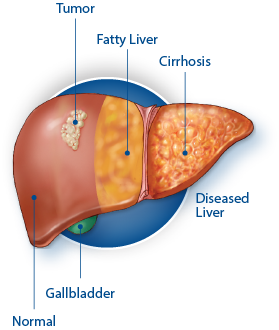What Is the Liver?
The liver is the largest internal organ in the human body and is considered a gland. It regulates your metabolism by processing what we eat and distributing energy in various forms to other cells in the body.
It is also the most important factory in the body, synthesizing proteins and enzymes necessary for digestion as well as detoxification and elimination of both internal (endogenous) and external (exogenous) products.
The liver has a unique position in the body and is both a vital part of our vascular (blood supply) system and connected to many organs, both physically, but also through constant communication via hormones and the nervous system. There are two main blood supplies to the liver, the portal vein and the hepatic artery. Because of the vast amount of blood that goes through the liver, the liver is constantly cleansing our blood as well as itself, by taking out rich nutrients needed for its operations.
What Is Liver Failure?
The liver can work normally even if damaged, but generally once more than 80% of the liver is damaged, the liver may start to fail. Most damage to the liver comes from viral hepatitis, alcohol, fatty liver, autoimmune conditions, and in some cases, genetic causes.
Damaged liver is replaced with collagen, which is called fibrosis. Fibrosis is given a staging system, generally with fibrosis stage 4 being cirrhosis of the liver.
Liver Cancer
The presence of stage 3 or 4 fibrosis is one of the main risk factors for the development of primary liver cancer. However, secondary liver cancers, or those that spread to the liver from other sites, often occur in completely healthy livers.
The diagnosis of tumors in the liver is of paramount importance so that treatment can begin quickly. Many times, a diagnosis can be made using blood tests and imaging such as CT or MRI scans. Occasionally, a biopsy of the lesion is required. The key is to move quickly once a lesion in the liver has been discovered.
How to Help Your Liver
There are a few things to consider in order to help keep your liver healthy and functioning properly. A healthy diet, regular exercise, and maintaining a normal body weight are some of the important things you can do to contribute to good liver health.
Avoid Excessive Alcohol and Watch Your Weight
Drinking too much alcohol can increase a person’s risk of developing fatty liver disease and cirrhosis of the liver. There is a confirmed correlation between excessive alcohol consumption and a high risk of developing these conditions. In fact, up to one in five heavy drinkers can develop alcoholic hepatitis, and one in four of those will develop cirrhosis.
Talk to your liver specialist and your dietician about how much alcohol is too much for you.
Obesity is another important risk factor for increased risk of liver disease. It can lead to fatty liver disease, and this can accelerate scarring of the liver. An important facet of good liver health is nutrition and exercise.
Our specialists at Texas Liver Tumor Center can help provide:
- Nutritional support
- Weight loss guidance
- Treatment of underlying liver disorders
Get Screened for Viral Hepatitis
Were you born between 1945 and 1965? If so, you are a baby boomer and are at risk of having hepatitis C.
Hepatitis is the most important risk factor for cirrhosis and liver cancer in the US. You should ask your physician to screen you for this potentially deadly, but curable disease. A simple blood test will make the diagnosis. Therapy for 8-12 weeks with very effective and safe medications is enough to cure 95% of people and halt the liver damage.
Get screened today if you are a baby boomer, or if you have ever engaged in behaviors that may have put you at risk for hepatitis. It could help prevent cirrhosis and liver cancer.

